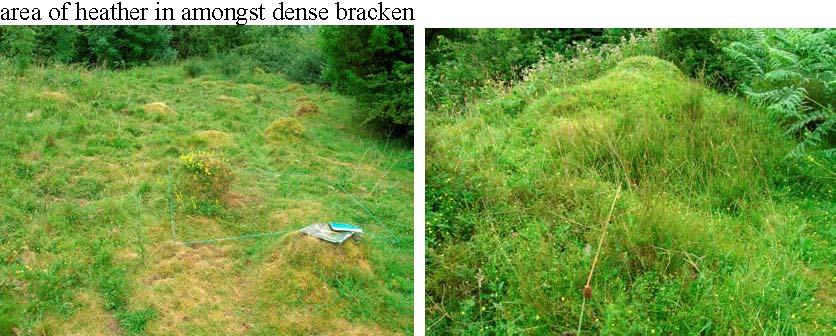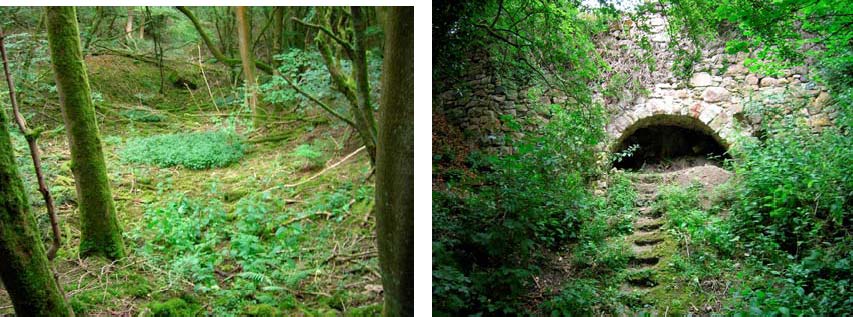| HOME | | | Overview | | | The Team | | | About | | | Newsletter | | | Contact | | | Links | | | Friends | | | The Novers | | | Benson Hydro | | |

|

|
The Novers Forest Garden Project | Preliminary Report on Habitat:
Preliminary Report on the Surface Archaeology and Structures
Site description:
For the most part, the site supports semi-natural, broadleaved woodland, however, at either end of the wood are small areas of species-rich calcareous and neutral grassland, dense bracken (Pteridium aquilinum) and a small area of heath.
The semi-natural broadleaved woodland (which is not recognised on the Ancient Woodland Inventory) falls within the NVC W8 Fraxinus excelsior-Acer campestre-Mercurialis perennis community. The woodland canopy is characterised by abundant ash (Fraxinus excelsior), with the occasional field maple (Acer campestre), yew (Taxus baccata) and an understorey of unmanaged hazel (Corylus avellana) coppice and scattered hawthorn (Crataegus monogyna). Wych elm (Ulmus glabra), elder (Sambucus nigra), holly (Ilex aquifolium) and bramble (Rubus fruticosus) occur less frequently as do pedunculate oak (Quercus robur), wild cherry (Prunus avium) and beech (Fagus sylvatica) in the canopy. A number of planted conifer trees including Scots pine (Pinus sylvestris) and European larch (Larix decidua) can be found close to the north-eastern boundary in and around the quarried section.
The ground flora is patchy and varies according to the undulating nature of the site. The most common species are ivy (Hedera helix), and dog’s mercury with damper patches supporting locally dominant ramsons (Allium ursinum). Other frequent species occurring throughout include wood anemone (Anemone nemorosa), enchanter’s nightshade (Circaea lutetiana), false brome (Brachypodium sylvaticum), herb robert (Geranium robertanium), sanicle (Sanicula europaea), wood sorrel (Rumex sanguineus) and wood avens (Geum urbanum). Conspicuomale fern (Dryopteris filix-mas) and broad buckler-fern (Dryopteris dilatata) are also scattered within. Other woodland species of note include bluebell (Hyacinthoides non-scripta), yellow archangel (Lamiastrum galeobdolon), common twayblade (Listera ovata), primrose (Primula vulgaris) and wood speedwell (Veronica montana). The moss Thamnobryum alopecurum is particularly abundant.
The vegetation in the former quarries is rather poor with small amounts of dog’s mercury, enchanter’s nightshade and sanicle but generally much locally dominant nettle in amongst abundant mosses Brachythecium rutabulum and Eurhynchium praelongum.
Located along the north-west perimeter of the wood is a small area of species-rich unimproved neutral grassland, which is surrounded by rank grassland and dense bracken (NVC U20 ). This rabbit grazed area of grassland with ant hills is recognised as the more calcifugous (NVC) MG5c sub-community. In amongst the frequent crested dog’s tail (Cynosurus cristatus), common bent (Agrostis capillaris), red fescue (Festuca rubra), sweet vernal grass (Anthoxanthum odoratum) and Yorkshire fog (Holcus lanatus) are heath grass (Danthonia decumbens) devil’s-bit scabious (Succisa pratensis), betony (Stachys officinalis) and tormentil (Potentilla erecta). Other species of note in this small but diverse grassland are bird’s-foot-trefoil (Lotus corniculatus), field wood-rush (Luzula sylvatica), smaller cat’s-tail (Phleum bertolonii), spring sedge (Carex caryophyllea), glaucous sedge (Carex flacca) common dog violet (Viola riviniana), common knapweed (Centaurea nigra), common milkwort (Polygala vulgaris), common spotted orchid (Dactylorhiza fuchsii) and rough hawkbit (Leontodon hispidus). Grazed ant hills characteristically support wild thyme (Thymus praecox), germander speedwell (Veronica chamaedrys), common mouse-ear (Cerastium fontanum), lady’s bedstraw (Galium verum), mouse-eared hawkweed (Pilosella officinarum) and juniper haircap (Polytrichum juniperinum). Spring turf-moss (Rhytidiadelphus squarrosus) also occurs frequently throughout.
Close to here and secluded within the dense bracken are a few isolated islands of common heather (Calluna vulgaris) intermixed with species-rich (NVC MG5c) grassland similar to that above.
On an area of steep, west-facing ground at the opposite end of the site the community changes entirely to a diverse calcareous grassland recognised as the (NVC) CG3 grassland, although this community clearly has a transition to mesotrophic grassland on level ground. Commoner grasses within this community include upright brome (Bromus erectum, false brome (Brachypodium sylvaticum), red fescue, crested dog’stail, smooth meadow-grass (Poa pratensis) and less frequently quaking grass (Briza media), heath grass and yellow oat-grass (Trisetum flavescens). The mosses Brachythecium albicans and Pseudoscleropodium purum are also frequent. A diversity of species occur here including cowslip (Primula veris), woolly thistle (Cirsium eriophorum), hoary plantain (Plantago media), yellow-wort (Blackstonia perfoliata), spring sedge (Carex caryophyllea), mouse-eared hawkweed, fairy flax (Linum catharticum), carline thistle (Carlina vulgaris), restharrow (Ononis repens), small scabious (Scabiosa columbaria), dyer’s greenweed (Genista tinctoria), wild thyme and common spotted orchid. This small area of grassland is under threat from the invasive hawthorn (NVC W21 Crataegus monogyna-hedera helix scrub), which presently occurs all over the steeper slopes. Ranker grassland with false oat-grass also occurs in transition with this scrub habitat. Less species-rich calcareous grassland occasionally occurs on the open banks of the track that passes through the wood.
A small patch of grassland located on level ground further west shares affinities with the calcareous grassland but is more mesotrophic falling within the NVC MG5 community. In amongst the Yorkshire fog, crested dog’s tail, red fescue, meadow buttercup (Ranunculus acris) and red clover (Trifolium pratense) are common knapweed, bird’s-foot-trefoil, lady’s bedstraw and burnet saxifrage (Pimpinella saxifraga). A larger glade located on the eastern side of the track in the same area has undergone some form of improvement and although a few species of unimproved grasslands remain towards the perimeter, the grassland is for the most species-poor.
Recommended site management:
As well as conservation woodland management it will be important to enhance and increase the area of calcareous grassland, neutral grassland and heathland by means of scrub, tree and bracken clearance. Bracken clearance should ensue with caution as it may provide habitat for specific fauna such as adder (Vipera berus).



